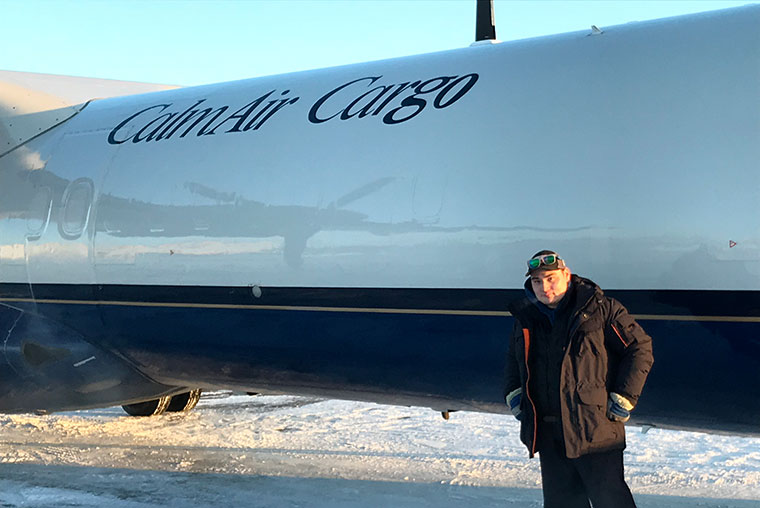Calm Air First Officer Breaks “Ice” Ceiling
Becomes Airline's First Inuk PIlot
By John Perkinson, Senior Staff Writer

F/O Jeremy Maley (Calm Air) stands by a Calm Air aircraft on a blustery winter day.
In the far northern reaches of Canada, you typically don’t see residents from local communities employed as a Calm Air pilot—that is, until now. Last September, F/O Jeremy Maley made history when he became the first Inuk pilot at Calm Air. The Inuit have long inhabited the Arctic regions of Canada, Alaska, and Greenland.
The ATR 42-72 first officer has achieved virtual celebrity status with his unique employment and is frequently approached on layovers by locals wanting to congratulate him. Among these well-wishers are young people who frequently ask how they can follow in his footsteps. “I really didn’t expect the reaction I’ve been getting,” Maley divulged. “It’s made my job a little bit busier, but that’s a good thing.”
Maley admitted that it’s great hearing the kind words and seeing smiling faces. Calm Air also appears to be pleased by Maley’s newfound fame. Finding new pilots to fly for the Thompson, Man.-based airline has been challenging in recent years, and the carrier has hinted that a program is in the works that could help other northern locals acquire their airline pilot wings.
Born to fly
While still a newcomer to Calm Air, the Yellowknife, N.W.T., resident has been flying all his life. “My dad owns a Cessna 185 Skywagon,” said Maley, who fondly remembers numerous trips sitting in the right seat of the float plane. Maley noted that his father let him fly the aircraft when he was 12, and he earned his Transport Canada civil aviation licence by the time he was 18.
Maley later earned a commercial aviation diploma from Okanagan College in Kelowna, B.C., and at 21 became a pilot for Calm Air. “I just thought having a career flying wouldn’t feel as much like a job,” he remarked. “At least, that was the goal.”
World of difference
Maley acknowledged that flying to and from the small communities around the Arctic Circle is a vastly different experience from what most ALPA members typically encounter. “The north seems to be a lot quieter with towns set far apart. At times you don’t hear much on the radio, which can be nice,” he noted.
For much of the year, the landscape includes vast white expanses, although the carrier does fly near the rugged Baffin Mountains. It’s common to see herds of migrating caribou in the Arctic tundra, as well as pods of beluga whales along the coast.
Maley observed that the view of the Northern Lights can be spectacular, but the extended winter darkness can take some getting used to. “Just a few weeks ago, I was in Resolute Bay around noon and it was pitch black. Then I flew a few hundred miles south and the sun was still out,” he said. “It throws off your natural clock quite a bit; but like the cold, it’s just something you have to get accustomed to.” Maley noted that in the summertime, the area’s fishing camps are an extremely popular destination for tourists who can enjoy the natural light for most of the day.
Because much of the terrain in these far north regions is barren, it tends to be windy. Couple this with plunging temperatures and massive snowfall accumulations and winters can be brutal. In 2008, the Kivalliq region of Nunavut experienced an eight-day blizzard during which air travel was impossible. “In my brief tenure with Calm Air, I’ve already witnessed five days of flight cancellations,” Maley said.
The area also offers an operational anomaly. “Once you get close to the magnetic north pole, your compass becomes unreliable with huge variations between ‘true’ and ‘magnetic’ north of up to 50 degrees,” observed Maley. “You need a nondirectional beacon in the air to compensate and accurately enter the data.”
While these conditions may seem challenging, it’s just another day for Maley who, like the locals from the towns and communities Calm Air serves, calls this striking landscape home. “I’m very happy where I am,” Maley said, adding that he hopes to see other Inuit pilots in an airline cockpit soon.

